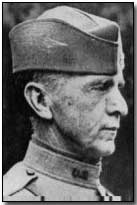Primary Documents - General John Pershing on the Battle of Cantigny, 28 May 1918
 In the wake of the
initially spectacular success experienced by the German Army during their
Spring Offensive, European calls for a rapid boost in the number of fighting
U.S. troops increased. In response a U.S. division (from the regular
army) was despatched to assist the British and French near Montdidier.
This division was instructed to launch a counter-attack against the Germans
at Cantigny, organised and undertaken solely by U.S. forces.
In the wake of the
initially spectacular success experienced by the German Army during their
Spring Offensive, European calls for a rapid boost in the number of fighting
U.S. troops increased. In response a U.S. division (from the regular
army) was despatched to assist the British and French near Montdidier.
This division was instructed to launch a counter-attack against the Germans
at Cantigny, organised and undertaken solely by U.S. forces.
The Battle of Cantigny - launched on 28 May 1918 and headed by General Robert Lee Bullard - saw a regiment from Bullard's 1st Division advance its front by 1.5km and which included the capture of the village of Cantigny. While a minor action of itself, the battle's significance came in the first attack launched by AEF forces.
Reproduced below is a brief summary of the German Army's approach at Cantigny by U.S. Commander-in-Chief John J. Pershing.
John Pershing on the Battle of Cantigny, 28 May 1918
On April 25th the First Division relieved two French divisions on the front near Montdidier and on May 28th captured the important observation stations on the heights of Cantigny with splendid dash.
French artillery, aviation, tanks, and flame throwers aided in the attack, but most of this French assistance was withdrawn before the completion of the operation in order to meet the enemy's new offensive launched May 27th toward Chateau-Thierry.
The enemy reaction against our troops at Cantigny was extremely violent, and apparently he was determined at all costs to counteract the most excellent effect the American success had produced.
For three days his guns of all calibres were concentrated on our new position and counter-attack succeeded counter-attack. The desperate efforts of the Germans gave the fighting at Cantigny a seeming tactical importance entirely out of proportion to the numbers involved.
Source: Source Records of the Great War, Vol. VI, ed. Charles F. Horne, National Alumni 1923
A "dogfight" signified air combat at close quarters.
- Did you know?
